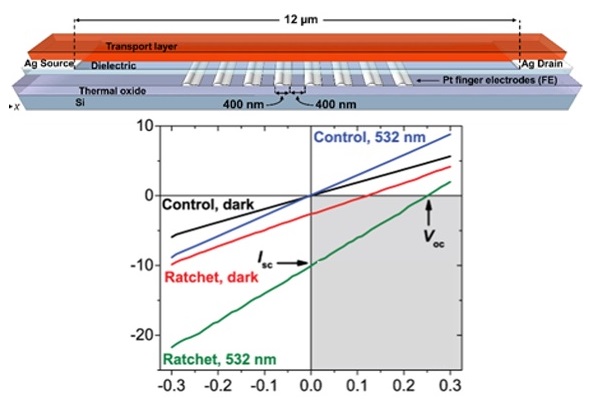A Light-Responsive Organic Electron Flashing Ratchet
Scientific Achievement
We have fabricated a room-temperature flashing electron ratchet (only the second such device to ever appear in the literature) from a blend of conjugated organic materials; upon the application of a shaped, oscillating gate potential, our devices not only produce a source-drain current in the absence of a source-drain bias, but also produce power.
Top: Design of the flashing organic electron ratchet device.

Bottom: Plots of current vs. source-drain voltage for a flashing electron ratchet device with (“532 nm”) and without (“dark”) illumination, and with (“Ratchet”) and without (“Control”) the flashing potential applied; the device only produces a short-circuit current Isc and an open-circuit voltage Voc with the flashing potential on. In the lower right quadrant (shaded), the ratchet is doing work.
Significance and Impact
This device can be driven by energy input in the form of a sine wave (an unbiased waveform); this result introduces the possibility of using natural oscillation sources (e.g., electromagnetic radiation) to drive ratchets, an important development toward their application in energy conversion.
Research Details
- A series of asymmetric Pt “finger electrodes” apply an oscillating electric field to the organic transport layer; the current is measured between Ag source and drain electrodes held at zero bias.
A Light-Responsive Organic Flashing Electron Ratchet
Kedem, O., Lau, B., Ratner, M.A., Weiss, E.A.
Proc. Natl. Acad. Sci. U.S.A. 114, 2017, 8698-8703.
Work Performed at Northwestern University
